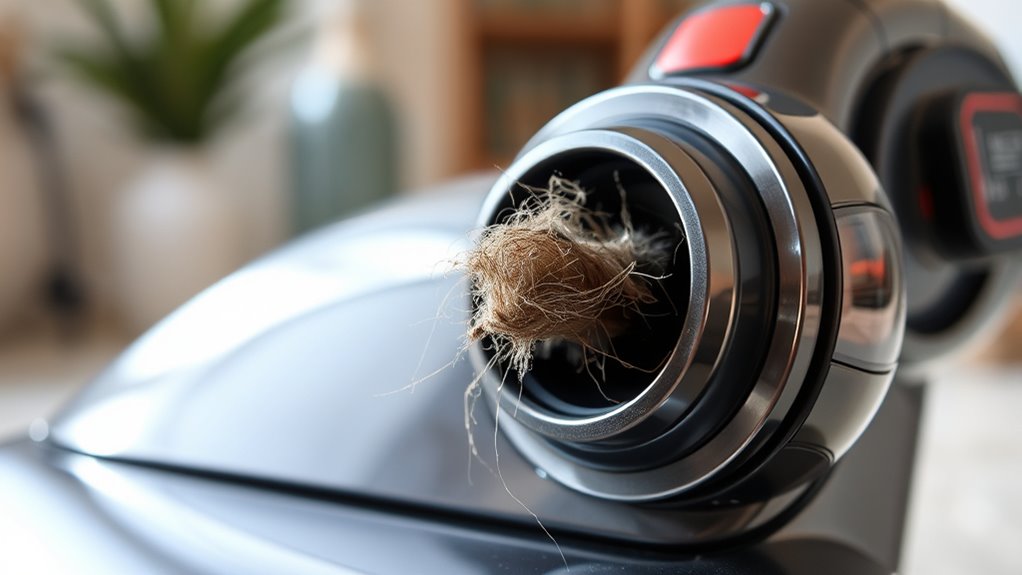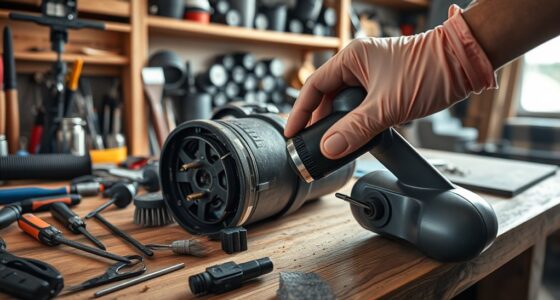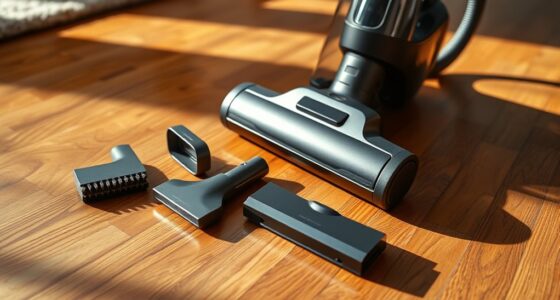If your vacuum is losing suction, start by checking and clearing blockages in hoses and attachments, as debris can restrict airflow. Regularly clean or replace filters, inspect the brush roll for tangled hair or damage, and make certain seals are tight and undamaged. Don’t forget to empty the dustbin or replace bags when full. Adjust the vacuum height for proper contact with the floor. For more tips, turn your attention to how these adjustments can restore peak performance.
Key Takeaways
- Regularly inspect and clear blockages in hoses, filters, and brush rolls to maintain optimal airflow.
- Clean or replace filters according to manufacturer guidelines to prevent airflow restrictions.
- Ensure seals and gaskets are intact and properly sealed to prevent air leaks.
- Empty dustbins and replace bags before they are more than 75% full to avoid suction loss.
- Adjust vacuum height and contact pressure for your floor type to optimize suction and cleaning efficiency.
Check and Clear Blockages in Hoses and Attachments
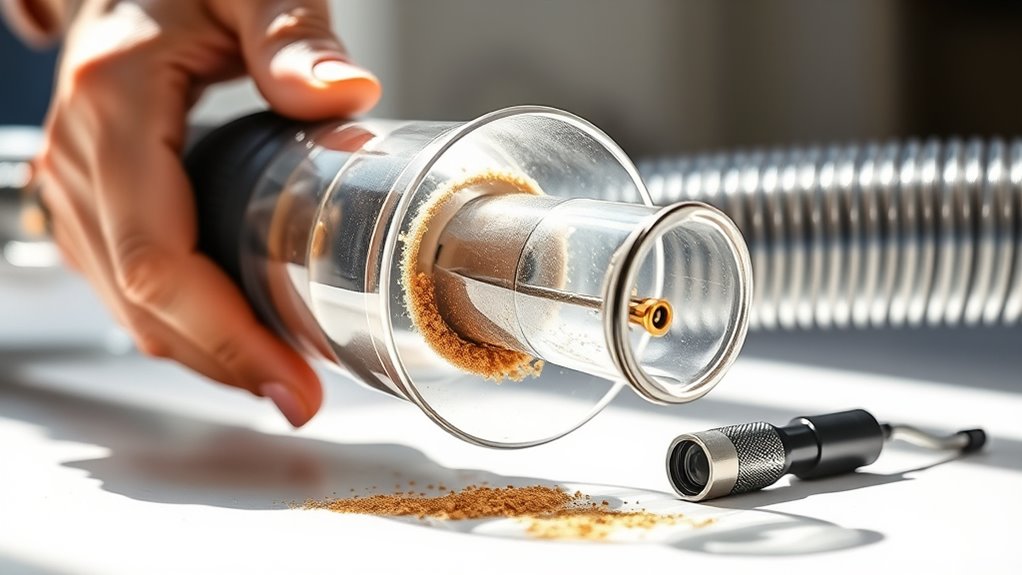
If your vacuum isn’t suctioning properly, blockages in hoses and attachments are often the culprit. Start with a thorough hose inspection, checking for any obstructions or debris that could restrict airflow. Detach the hose and look inside—use a broomstick or similar tool to gently push out any blockages. Don’t forget to clean your attachments too; dust and hair can accumulate and hinder suction. Run water through the attachments if they’re washable, ensuring they’re completely dry before reattaching. Clearing these blockages restores proper airflow, improving your vacuum’s suction power. Regular hose inspection and attachment cleaning are simple yet effective steps to prevent loss of suction and keep your vacuum working efficiently. Staying aware of filter maintenance can also help maintain optimal performance and prevent airflow issues. Additionally, inspecting and replacing worn vacuum belts can significantly improve suction strength. Performing routine vacuum cleaning checks and maintaining other components can help you catch problems early and extend the life of your appliance. Being mindful of airflow obstructions can further prevent blockages and maintain suction efficiency. Staying proactive to avoid more serious issues down the line, and remember that air purifier maintenance can also influence indoor air quality and appliance performance.
Replace or Clean the Vacuum Filter Regularly
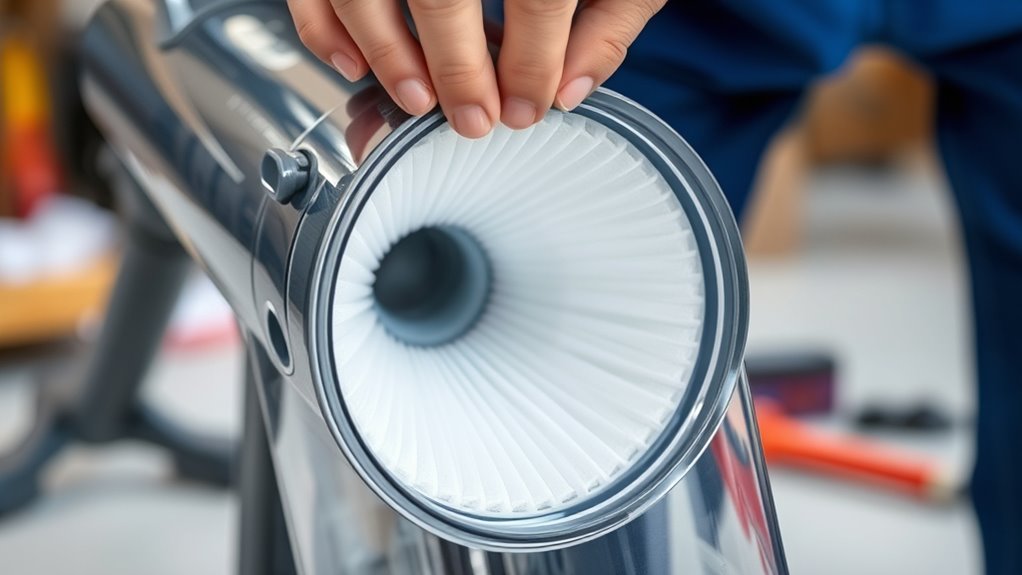
Regularly replacing or cleaning your vacuum filter is key to maintaining strong suction. When filters get clogged or dirty, airflow is restricted, reducing cleaning efficiency. Make sure to follow proper cleaning techniques to keep your vacuum performing at its best. Utilizing high-quality filters can also enhance overall performance and prolong the lifespan of your vacuum filter replacement. Additionally, selecting airflow optimization options such as ECU remapping and performance upgrades can optimize engine efficiency and power, similar to how regular filter maintenance keeps your vacuum running smoothly. Being aware of precious metals market trends can also help you make informed decisions to protect your investments and ensure long-term security. Incorporating proper yoga practices into your routine can help reduce physical tension and improve your overall well-being.
Filter Maintenance Importance
Have you noticed your vacuum losing suction power or working harder than usual? Regular filter maintenance is vital. A dirty or clogged filter hampers airflow, making your vacuum less efficient. By performing timely filter replacement or cleaning, you guarantee optimal airflow, which improves suction performance. Neglecting this step allows dirt and debris to build up, decreasing your vacuum’s effectiveness and straining the motor. Consistently maintaining your filter not only prolongs the lifespan of your vacuum but also guarantees thorough cleaning. Keep an eye on the filter’s condition and follow the manufacturer’s recommendations for cleaning or replacing it. This simple step greatly boosts suction power and keeps your vacuum functioning at its best. Proper filter maintenance is a key part of preventing suction problems. Additionally, staying informed about HEPA filtration and other air purification technologies can help you understand the importance of regular checks and updates to keep systems running smoothly. Regularly inspecting and upgrading filters can also support air quality and overall device performance.
Proper Cleaning Techniques
To guarantee your vacuum maintains peak suction, it’s essential to replace or clean the filter on a consistent basis. Proper cleaning techniques help optimize airflow, directly enhancing suction power. Begin by inspecting the filter regularly, removing dust and debris that block airflow. Wash reusable filters with water, ensuring they’re fully dry before reinserting. For disposable filters, replace them according to the manufacturer’s schedule. Keep the vacuum’s brush rolls and vents clean to prevent blockages that reduce suction. Maintaining these components ensures efficient airflow and prolongs your vacuum’s lifespan. A well-maintained filter and clean components work together to maximize suction power, making your cleaning more effective. Regular upkeep prevents suction loss and keeps your vacuum performing at its best. Additionally, understanding the importance of air quality and proper maintenance can help extend the life of your vacuum and ensure it continues to operate effectively. Being aware of filter types and their proper care can further improve your vacuum’s performance and longevity.
Inspect and Maintain the Brush Roll and Beater Bar
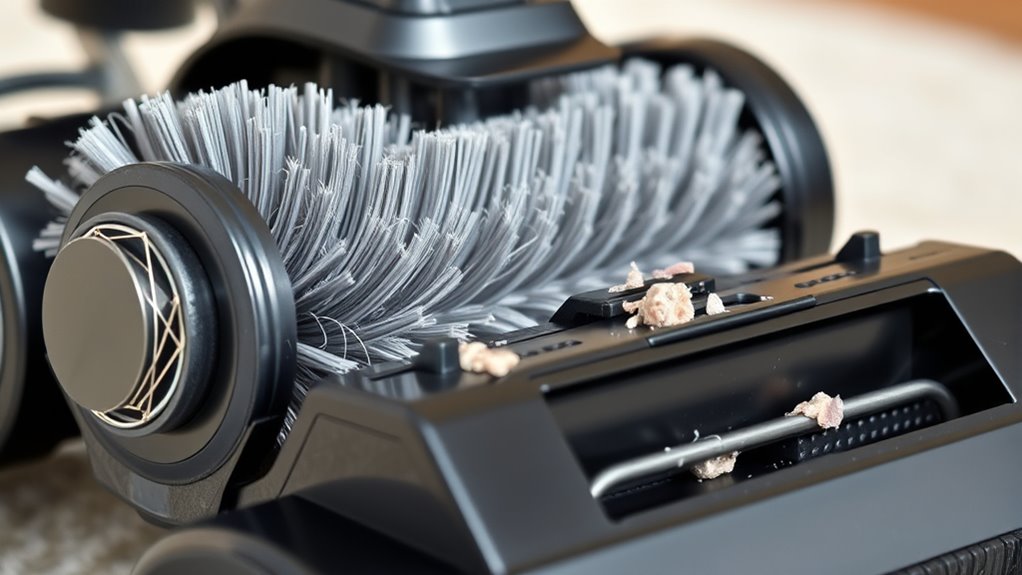
You should regularly check the brush roll and beater bar for hair and debris buildup, which can block airflow. Make sure to remove any tangled strands and clean the components thoroughly. Also, inspect for worn or damaged parts that might affect your vacuum’s performance. To prevent overaccumulation, consider using a self watering plant pot to maintain proper moisture levels for your indoor plants. Regular maintenance of vacuum components can help ensure consistent airflow efficiency and prolong the lifespan of your device. Additionally, keeping your vacuum well-maintained aligns with noise reduction technology principles, ensuring quieter operation and better overall performance.
Clear Hair and Debris
Is hair and debris clogging the brush roll or beater bar causing your vacuum’s suction to weaken? Hair buildup around the brush roller can restrict airflow and reduce cleaning efficiency. To fix this, regularly inspect your vacuum’s brush roller and beater bar for tangled hair and debris. Remove any hair or fibers wrapped around the roller, as they can hinder movement and suction.
- Detach the brush roller and clear away hair buildup using scissors or a brush.
- Check for tangled hair or debris lodged in the beater bar or around the brush.
- Clean the area thoroughly to ensure smooth rotation and proper airflow.
Keeping your brush roller free of hair and debris helps maintain strong suction and prolongs your vacuum’s lifespan. Regular maintenance is key to effective cleaning.
Check for Worn Components
Have you checked whether the brush roll and beater bar are worn or damaged? Worn components can reduce suction power and cause clogs. Inspect the brush roll for any cracks or broken bristles, and ensure the beater bar spins freely. If you notice signs of wear, consider belt replacement to keep everything running smoothly. A loose or broken belt can prevent the brush from rotating properly, affecting suction. Also, perform a motor inspection to ensure it’s functioning correctly; overheating or unusual noises can signal issues. Clear debris or hair buildup from the brush and replace worn parts promptly. Regular maintenance of these components helps maintain ideal suction and prolongs your vacuum’s lifespan.
Ensure Proper Seal and Check the Gasket Integrity
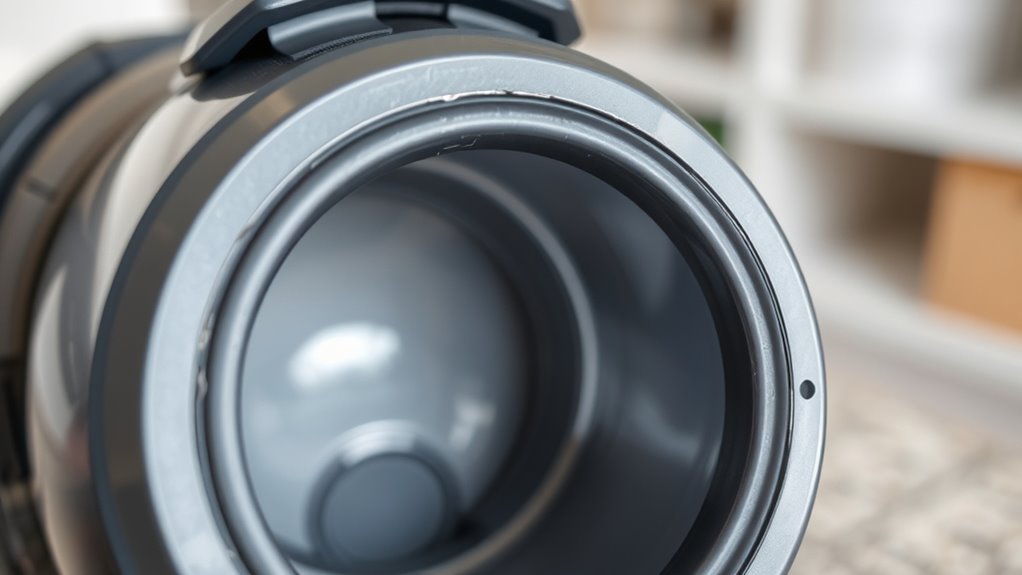
A proper seal is essential for maintaining vacuum pressure, so inspecting it thoroughly can prevent suction problems. Check the gasket regularly to guarantee seal integrity, as worn or damaged gaskets can cause leaks and loss of suction. During gasket inspection, look for cracks, tears, or hardened areas that might compromise the seal. If you notice any issues, replace the gasket immediately to restore ideal vacuum performance. Proper sealing also involves ensuring that all connections are tight and correctly aligned. Regularly cleaning the gasket and sealing surfaces helps prevent buildup that could weaken the seal. Remember, a well-maintained seal ensures consistent suction, improving your vacuum’s efficiency and lifespan.
- Inspect for cracks or tears in the gasket
- Ensure all connections are tight
- Clean sealing surfaces regularly
Empty the Dustbin or Replace the Bag Promptly
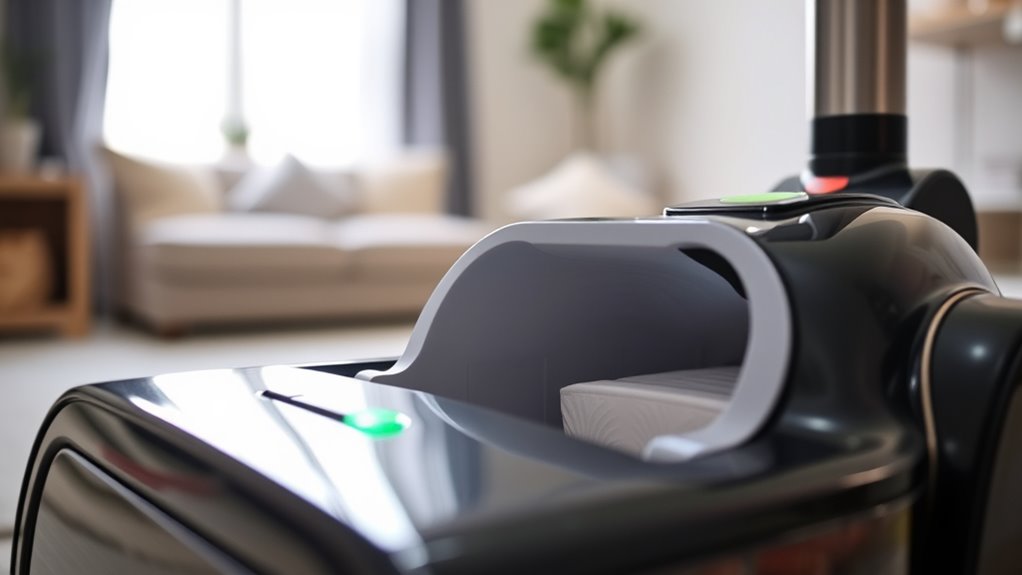
Regularly emptying the dustbin or replacing the vacuum bag is essential for maintaining peak suction. When the dustbin fills or the bag becomes full, airflow decreases, reducing cleaning effectiveness. Make it a habit to check and perform dustbin emptying or bag replacement frequently. This simple step prevents suction loss and keeps your vacuum running efficiently.
| Dustbin Emptying | Bag Replacement |
|---|---|
| Empty when 75% full to prevent clogging | Replace when the bag is nearly full to sustain airflow |
| Do it regularly for ideal suction | Change immediately if odor or damage appears |
| Use proper disposal methods | Use compatible bags for best fit and performance |
| Check for blockages after emptying | Avoid overfilling to prevent debris escape |
Verify the Vacuum’s Height Setting for Proper Contact
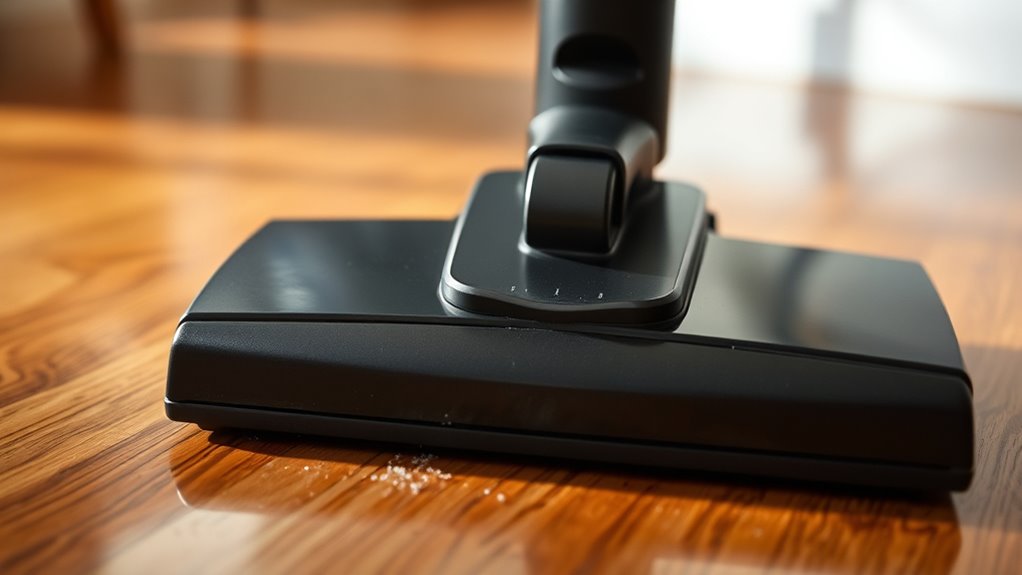
Making sure your vacuum’s height setting is correct is essential for effective cleaning. If it’s too high, the brush won’t make proper contact with the floor, reducing suction. If it’s too low, it can cause excessive contact pressure, damaging the brush or floor. To verify the height adjustment, check your vacuum’s manual for recommended settings based on your floor type. Adjust the height so the brush just touches the surface without pressing down hard.
- Confirm the height adjustment aligns with your flooring
- Make certain the brush maintains proper contact pressure
- Test suction and make fine adjustments as needed
Schedule Routine Maintenance and Troubleshooting Checks
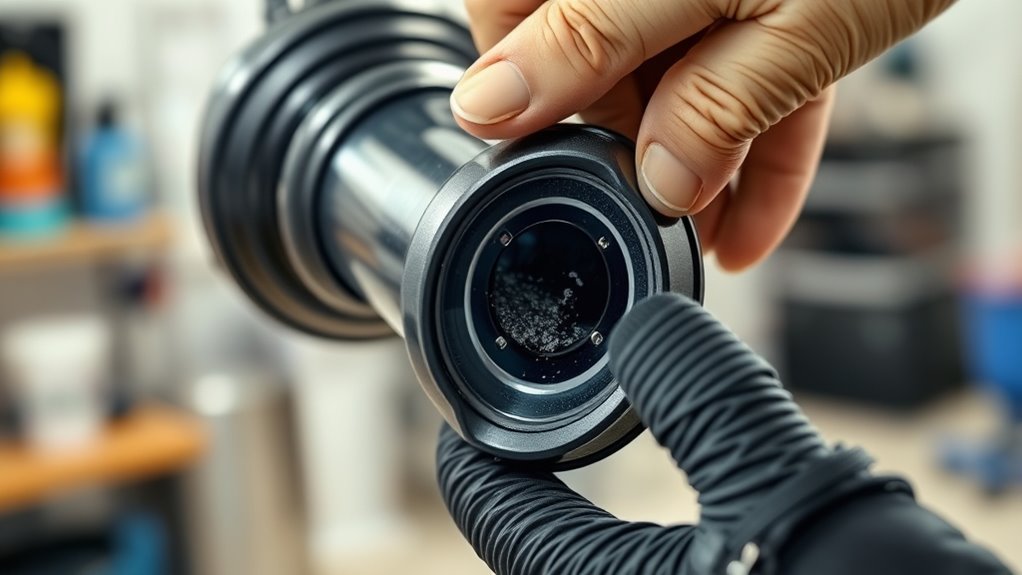
Scheduling routine maintenance and troubleshooting checks helps keep your vacuum performing at its best. Regular vacuum scheduling ensures you catch issues early before they cause significant loss of suction. During routine inspections, check for clogged filters, blocked hoses, and debris buildup in the brush roll. Clean or replace filters as needed, and clear any obstructions that could restrict airflow. Don’t forget to inspect the belt and brush for wear and tear, replacing them if necessary. Performing these tasks consistently minimizes the risk of losing suction and prolongs your vacuum’s lifespan. If you notice persistent problems despite routine inspections, troubleshooting can help identify underlying issues like motor faults or blockages. Making maintenance a regular habit keeps your vacuum in excellent condition and reduces downtime.
Frequently Asked Questions
How Do I Identify if My Vacuum Has a Leak?
To identify if your vacuum has a leak, first check the vacuum hose for any cracks or loose connections. Listen for hissing sounds that indicate air leaks, especially around the hose, seals, or attachments. You can also hold a paper towel near suspected areas to see if it’s pulled toward them, revealing air leaks. Regularly inspecting these parts helps prevent suction loss and keeps your vacuum working efficiently.
Can External Debris Cause Suction Loss Outside the Filter Area?
A stitch in time saves nine, and that’s true for your vacuum too. External debris outside the filter area can block airflow, causing suction loss. Even if the filter isn’t blocked, debris around the seals or hose connection can restrict suction. Regularly check for external debris and make certain the filter and hoses are clear. Keeping your vacuum clean outside and in prevents loss of suction and keeps it running smoothly.
What Are Signs of a Worn-Out Gasket or Seal?
You’ll notice signs of a worn-out gasket or seal through visible cracks, brittleness, or tears. Seal degradation often causes air leaks, resulting in reduced suction power. If you hear hissing sounds or see a decrease in vacuum efficiency, gasket deterioration might be the culprit. Regularly inspecting and replacing damaged gaskets or seals helps maintain ideal suction and prevents further vacuum issues.
How Often Should I Perform Routine Vacuum Maintenance?
You should perform routine vacuum maintenance every 1 to 3 months, depending on usage. Regularly check and replace the vacuum filter to maintain ideal airflow. Additionally, clean the brush agitation area to prevent debris buildup, which can reduce suction. Maintaining your vacuum with these simple steps ensures it operates efficiently, prolongs its lifespan, and prevents issues like losing suction during cleaning sessions.
Is It Normal for Suction to Vary During Cleaning?
Ever notice your vacuum acting like a drama queen, with suction fluctuating and making odd vacuum noises? Don’t worry—it’s quite normal. Your vacuum might get moody during cleaning due to uneven surfaces or clogged filters, causing suction variation. Just remember, a little vacuum noise and suction fluctuation are part of the show. Regular maintenance keeps the performance steady, so your vacuum stays a reliable partner, not a temperamental diva.
Conclusion
To keep your vacuum suction strong, stay on top of regular maintenance like checking filters, clearing blockages, and ensuring proper seals. Think of your vacuum as a loyal engine—when all parts work together smoothly, it performs like a champ. Don’t let small issues pile up; address them promptly. With a little TLC, you’ll keep your vacuum running like a well-oiled machine, making cleaning less of a chore and more of a breeze.
